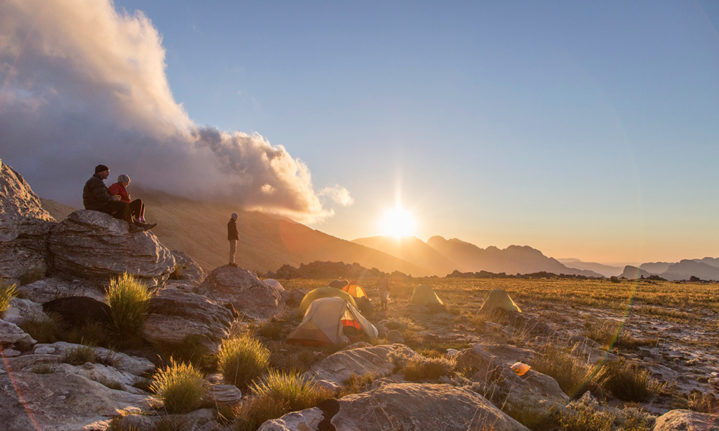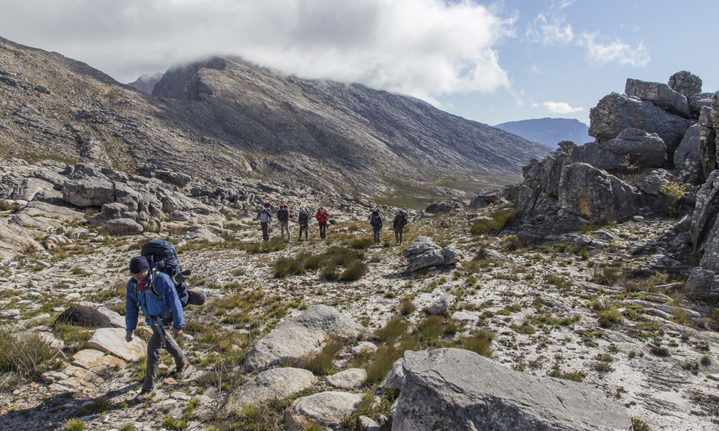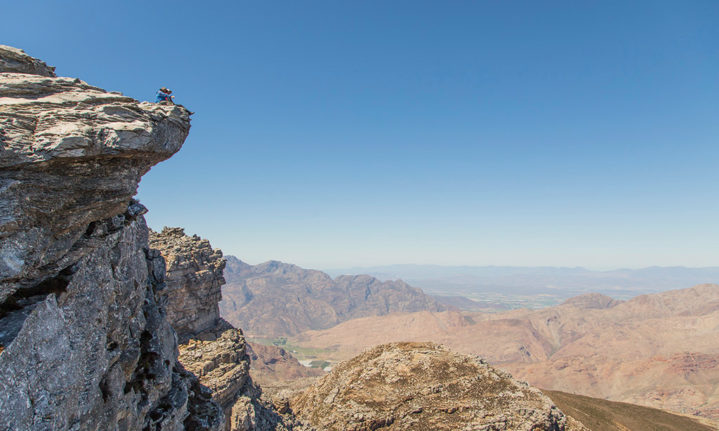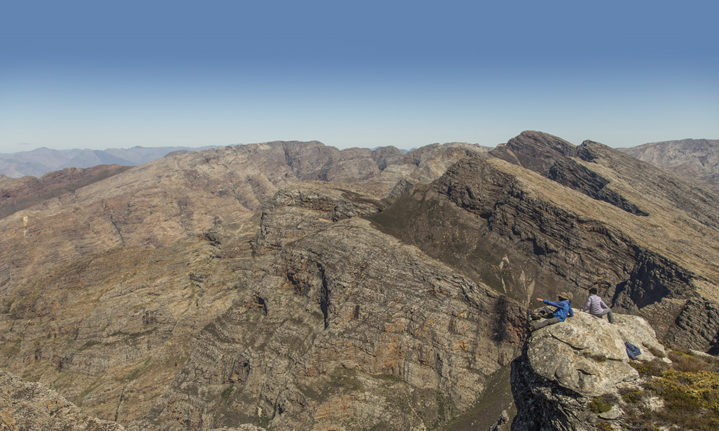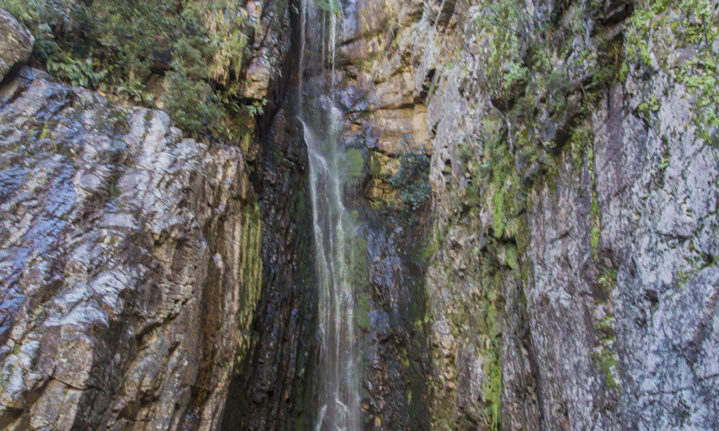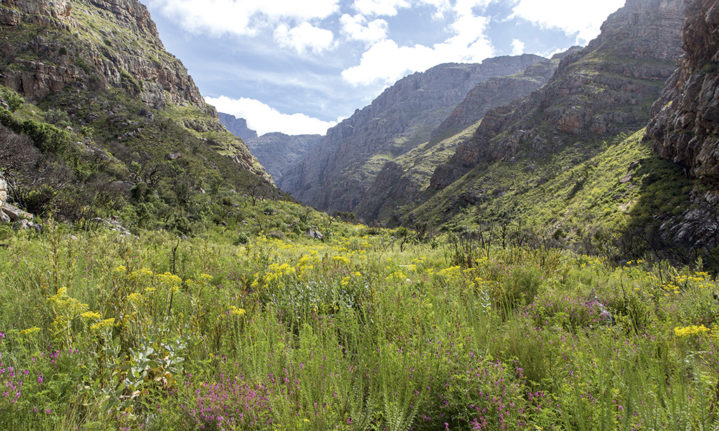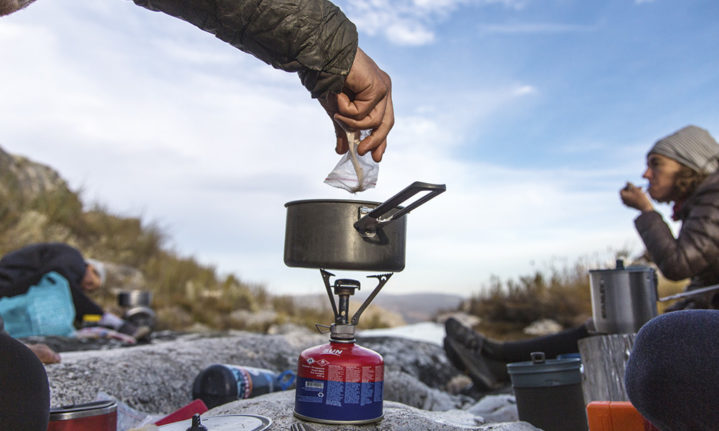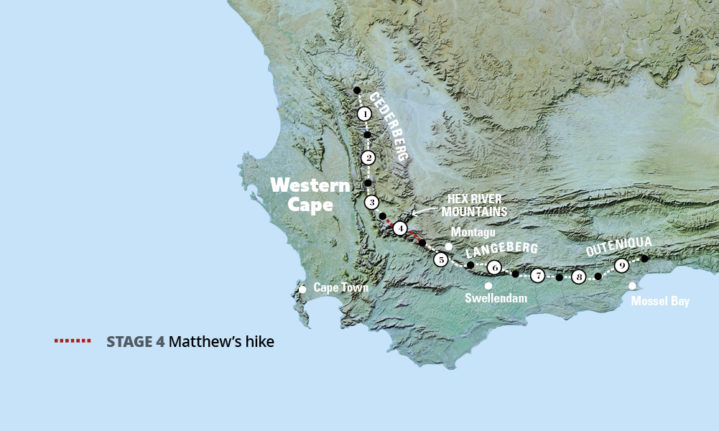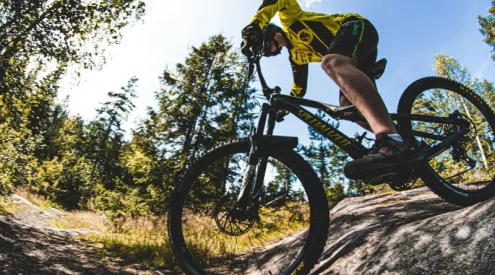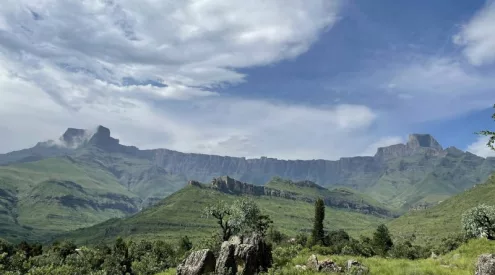The Rim of Africa is a nine-week, 650km mega-traverse of the Cape Fold Mountains. More than just a very long walk, it offers hikers full immersion in the mountain wilderness of the Western Cape.
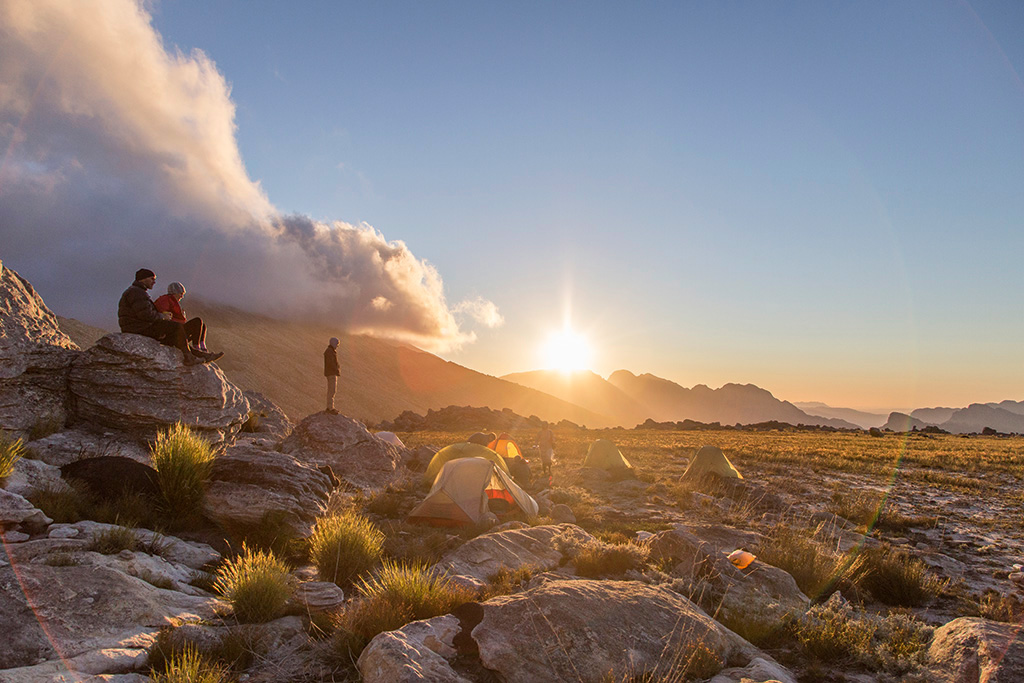
Our campsite on Milner Vlakte provided the best sunset of the trip, with extensive views over the Koue Bokkeveld.
In the recesses of my dream came the distant sound of chattering swifts and falling water. The unusual combination lured me back to consciousness as I peeled open an eye to see a grey dawn coming through the trees that formed my shelter. It took a moment to remember where I was – at the end of a long kloof below a massive amphitheatre. My eyes slowly adjusted and I noticed the imposing wall rising 260m above me, a small waterfall shooting off the top of it and creating a trailing mist that fanned across the valley floor. A tiny rainforest of moss, long grass, ferns and a gnarled Cape holly is continuously watered by its spray.

There are no set paths on the Rim of Africa. The guides rely on memory and notes from other guides who have been there more recently.
We’d arrived the evening before and slipped gratefully into our sleeping bags as soon as night fell, exhausted by an arduous hike down into the amphitheatre followed by an hour of boulder hopping. Snug in my warm bag, I watched the swifts dart in and out of the rock crevices, catching insects, then closed my eyes for a little longer. I would need all the rest I could get for this week of off-trail hiking, carrying all my own supplies and sleeping rough in the open.The Rim of Africa is a 650km ultra-hike along the Cape Fold Mountains, stretching from the Cederberg in the west to the Outeniqua foothills in the east, forming the southwestern rim of the African continent. The trail is divided into nine traverses that can be completed in one go, called a thru-hike. It’s more common, however, to do it one section at a time. Some people return every year to carry on where they left off (making it a nine-year hiking project). The traverses, they say, are all different. The two-and-a-half-month-long hike sets off once a year in spring, when the fynbos is at its best and the weather is supposed to be cool and clear.
I joined the fourth traverse, which started in Ceres and ended on a farm halfway between De Doorns and Montagu. There were six hikers and two guides in our group, all previous strangers brought together by a love of mountains. We moved relatively slowly, at a pace that came naturally to us. We ate when hungry and rested when tired. Routes and campsites change every year according to the whims of the group. I like to think of it as a choose-your-own-adventure kind of trail. ‘We’re not here to race between campsites,’ Johann Lanz, our guide, told us on the first day. ‘We’re here to just be in the mountains and move with the rhythms of nature.’ Johann is a soil scientist by trade and poet-philosopher by nature. His traits, like his life, have been shaped by the mountains he spends his days in. The knowledge he brings to the trail is all his own; there are no scripted speeches or curated experiences on the ‘Rim’. It’s more assisted hiking than guided in the traditional sense, and we had to be completely self-sufficient – cooking our own food and pitching our tents.
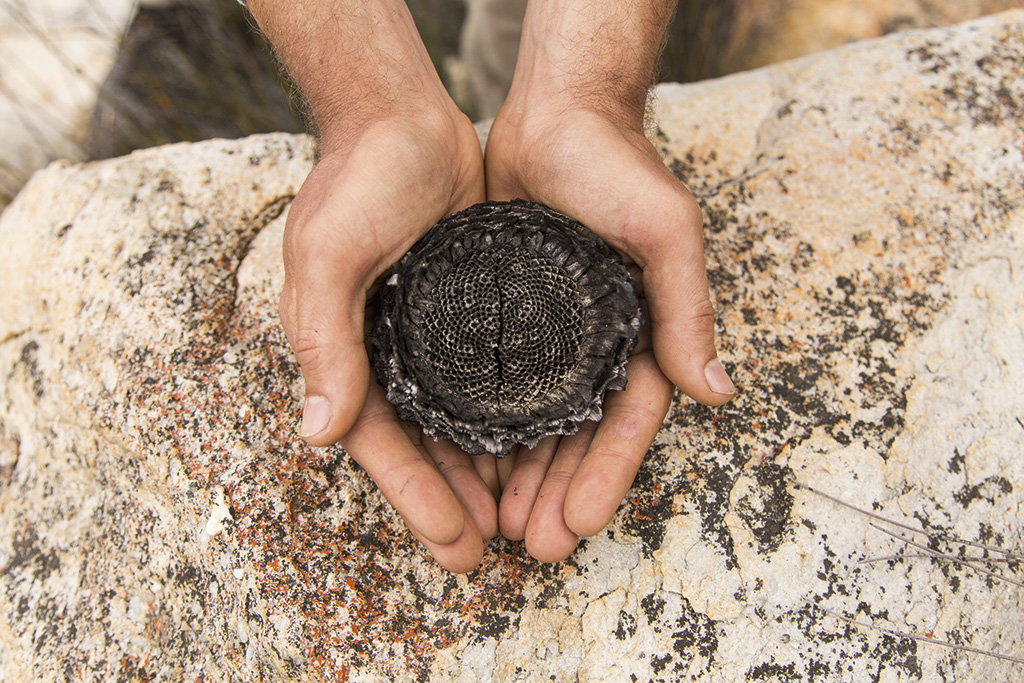
The natural geometric pattern of a burnt protea was a captivating trail-side discovery.
When the trail started in 2009, the food was catered but the guides soon realised this created the wrong atmosphere. ‘Being self-sustainable is part of the spirit of the journey,’ Johann said. Other aspects are engaging fully with nature – watches are banned, for example – and with yourself. Mornings are for checking in with everyone to see how they’re feeling, physically and emotionally. They’re also a time for poem readings and walking in silence. Both served to make us more appreciative and aware of the landscape and experience. This was the idea from the outset, when Ivan Groenhof envisioned what the Rim could be. In the early 2000s, Ivan had become disillusioned with a career in construction and decided to seek ‘an African solution to an African problem’ by speaking to a sangoma. The traditional healer brought up the concept of a ‘walkabout’ and Ivan embraced it. He spent a month ‘in the hills’ and came back with the idea for the Rim, whereby people could reconnect with both themselves and the world around them. Exposed to the wilderness, Ivan maintained, people would also be more likely to conserve it. Establishing the trail required a colossal effort of obtaining access permission from more than 200 landowners.
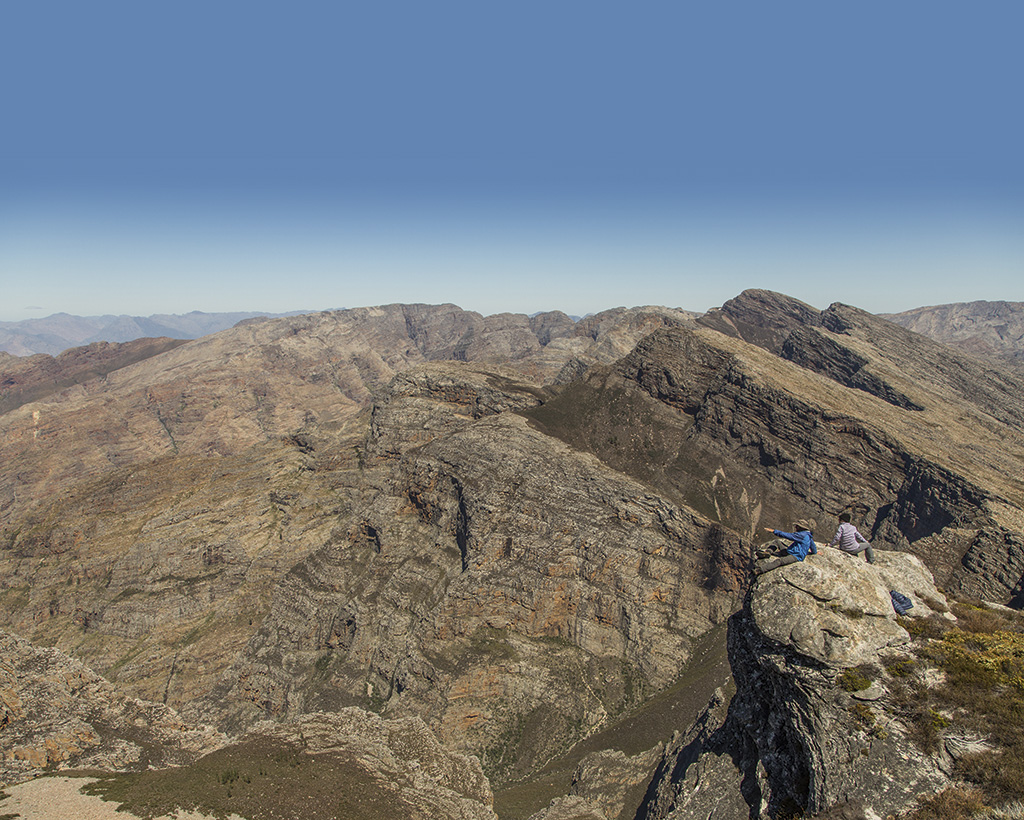
Johann Lanz was an astute guide who didn’t only share his knowledge but also his personal insights, such as, ‘As I walked along the trail, I was struck by the contrast between the immensity of the mountains and the fragility of the flowers.’
Our hike initially took us through orchards near Ceres and then up a path, that only Johann could see, into the Hex River Mountains for two days. Although the Rim is an established hiking trail, it doesn’t follow a constructed path. We finally reached a grassy plateau with views looking back towards the Koue Bokkeveld and Cederberg, where the Rim expedition had started weeks before. It was here that we entered true mountain wilderness, where the clouds enveloped us and the night winds grew fierce. We encountered fascinating elements around every bend – leopard spoor, thumb-sized succulents, clumps of burnt proteas, the call of a Victorin’s warbler, shards of quartz, a lingering patch of snow, the scent of flint, and wild flowers with their purple petals bent backwards like broken beach umbrellas. At times, we kicked up pollen from the fynbos which disappeared like puffs of smoke. We swam in rock pools – either a deep dark brown or a diamond blue – at the end of most days. And always, we had the mountains for company.
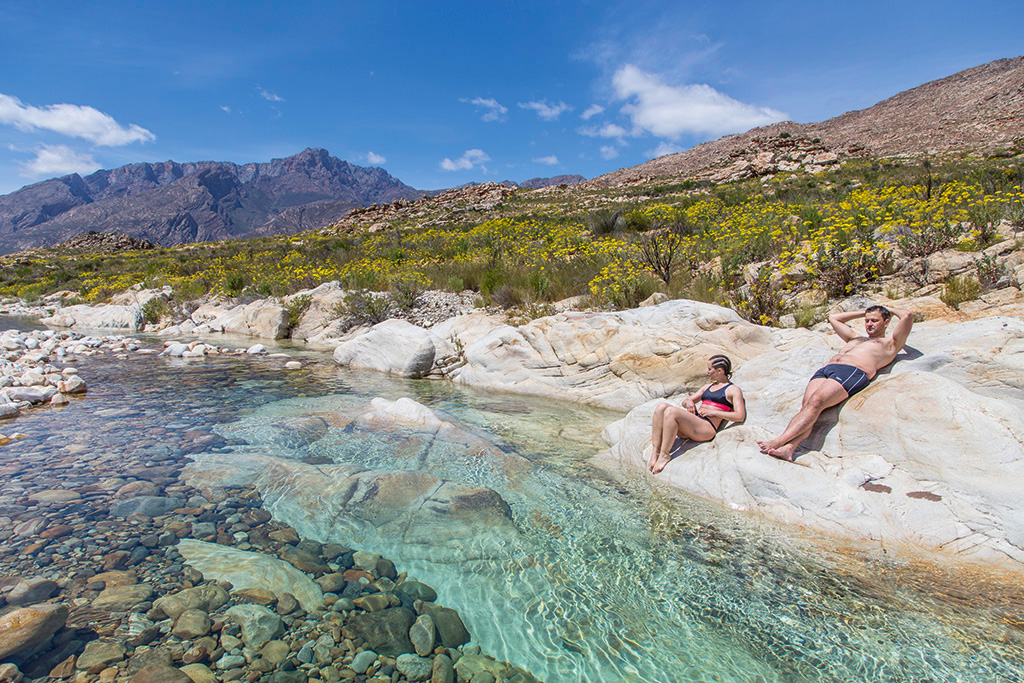
LeRiche Coetzee and Matthew Dalby take it easy in the sun after discovering this crystal pool just outside De Doorns.
All the major ranges in the world – the Himalayas, Alps, Andes and Rockies – are relatively young compared to our Cape Fold Mountains. They still have crisp peaks and ridges, while our mountains look like weather-beaten old men, full of wrinkled crevices, cracks and caves. Geologists estimate the Cape mountains were seven times the height they are now around 300-million years ago. It’s difficult to comprehend, but what we were walking on are really just the crumbling ruins of once-dizzying giants. ‘I find it incredible that this mountain will eventually dissolve and end up in the sea,’ Johann told us one afternoon as we looked onto the clear folds of a neighbouring peak. ‘These mountains are still wearing down and crumbling. If we were to show this movement in compressed time, it’s like a geological flowering. The mountains rise, open up, bloom and drop petals like a flower, which are then washed to the sea and the next flower opens up.
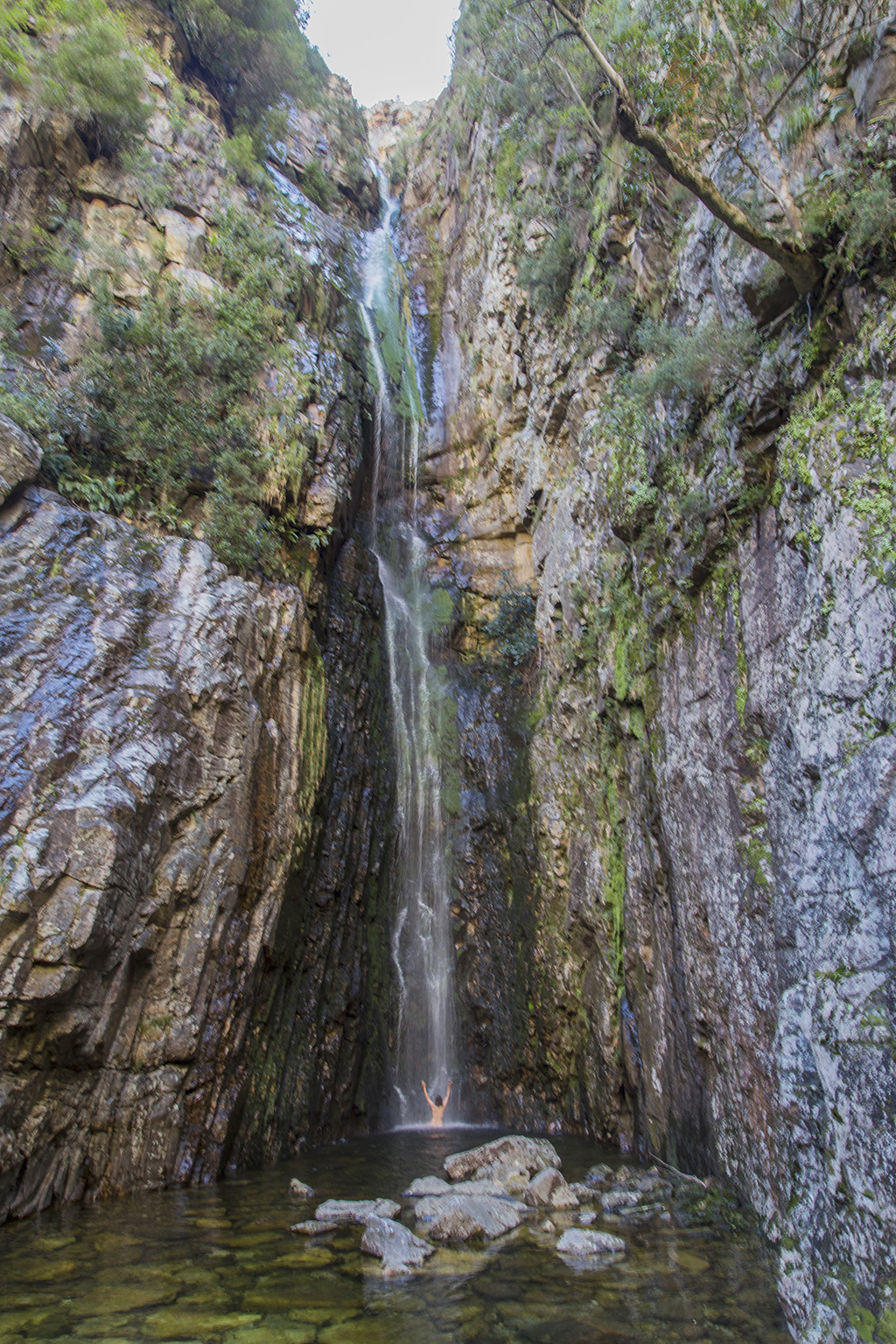
An impromptu naked splash in a waterfall ensured a cooler afternoon. We found leopard markings on a tree not far from this pool.
One afternoon, I fell into step with Evan Feinberg, an outdoor educator from New York and the only remaining thru-hiker still going. The other two had bailed out a couple of weeks earlier with injuries. Evan has a thing for long trails. He’s been on extended hikes in Patagonia, New Zealand and the Appalachian Trail in his homeland. ‘It’s the best way to see a country,’ he said. ‘It’s really epic to do the entire trail. As they say, go big or go home.’ Evan is not the only one to feel this way. In recent years, thru-hiking has experienced a surge in popularity across the globe. Some credit the new interest to popular books like Wild by Cheryl Strayed (about her journey on the Pacific Crest Trail up the west coast of the USA). Others believe it’s simply millennials seeking extended experiences with nature in response to modern living. Whatever the case, new mega-trails are popping up all over the world. The Via Dinarica, a 2,000km trail in the Balkans, was launched fairly recently; the Transcaucasian Trail is a 3,000km hike being developed across Armenia and Georgia.
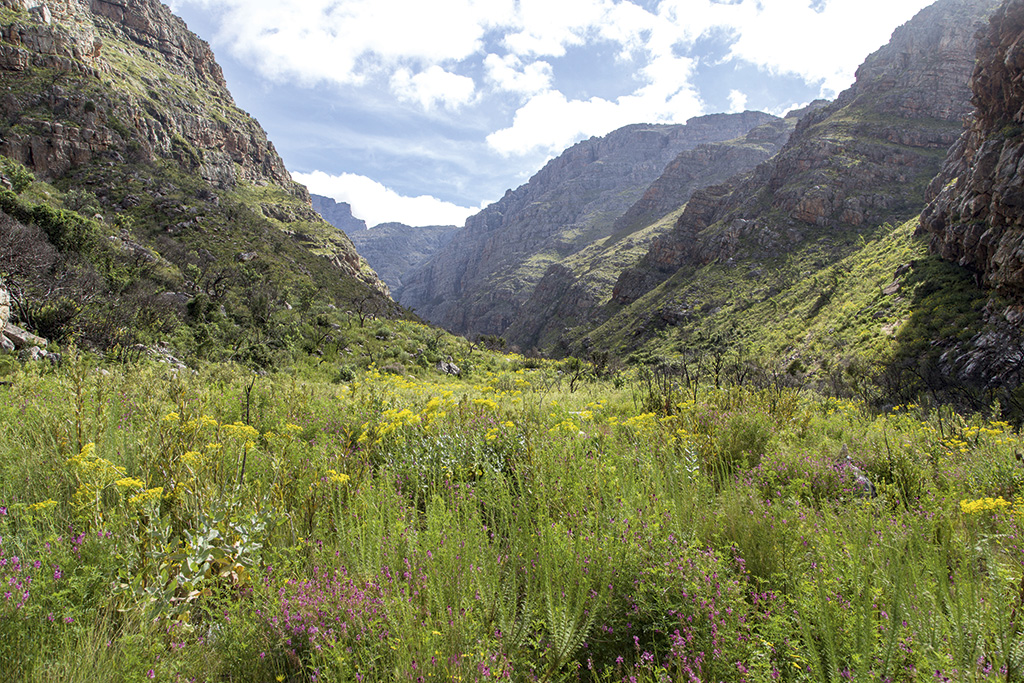
Hiking in spring means you walk through fields like this. It was fascinating to see the fynbos change as we entered different sections.
The Rim of Africa is a challenging hike. Because there’s no defined path it requires your body, and your mind, to navigate the way. This means you’re always fully engaged with what you’re doing in the moment. It’s not for everyone and can be too demanding for some hikers (four out of 16 didn’t finish the first traverse). But for those seeking a deeper experience of a mountain wilderness, the Rim provides that – and then some. On the section I walked, we slept in our tents on only two nights. And our campsites reflected the diversity of the terrain – next to a river in a meadow of liquorice-smelling buchu; on a plain facing west for a sunset that glowed long after dark; near a swirling waterfall; in a forested kloof where baboons watched us from above; in a small clearing close to a rock-art site; and beside a series of pools where we watched the sunrise from our sleeping bags.
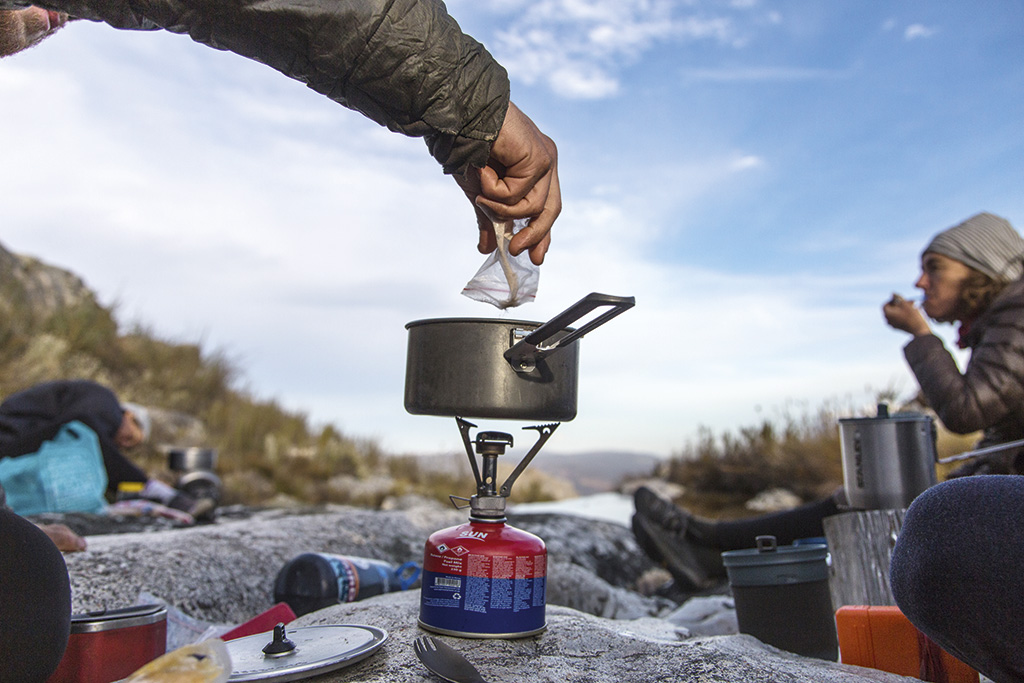
Much chatter on the trail revolved around what was for dinner. We often cooked alongside rivers to make use of the water.
On my first night, lying in the meadow of buchu and looking up at the stars, I took a deep breath and felt myself decompress. All my anxieties and stresses seemed to rise up and be swallowed by the stars. By the fifth day, I found myself laughing louder and longer than I normally would. I was on a mountain high. Being immersed in nature like we were obviously takes you closer to it. But better still, it brought me closer to my own true nature. That’s why it felt like going home.
Plan Your Trip
Getting There
Transfers are provided from Cape Town.
When to Go
The 2019 hike is from 24 September to 18 November.
Need to Know
The Rim of Africa is for experienced and fit hikers looking for a meaningful mountain experience. The guides are there for navigation, safety and knowledge, but you supply your own camping gear and food (and cook it yourself). One resupply point per traverse removes trash and delivers pre-packed food and clothes. We hiked between six and eight hours a day, reaching camp by late afternoon.
Booking and Cost
This year marks the 10th anniversary of the Rim of Africa, and to celebrate, it’s being offered at half price: R2,000 per section plus R395 pp a day. This includes permits, two professional guides, medical supplies and satellite phone, indemnity insurance, logistics and food drops. There are also several sponsored spots for those who can’t afford the cost, thus giving greater access to the mountains for people who may otherwise never get this kind of opportunity. Applications close on 28 June 2019. rimofafrica.co.za
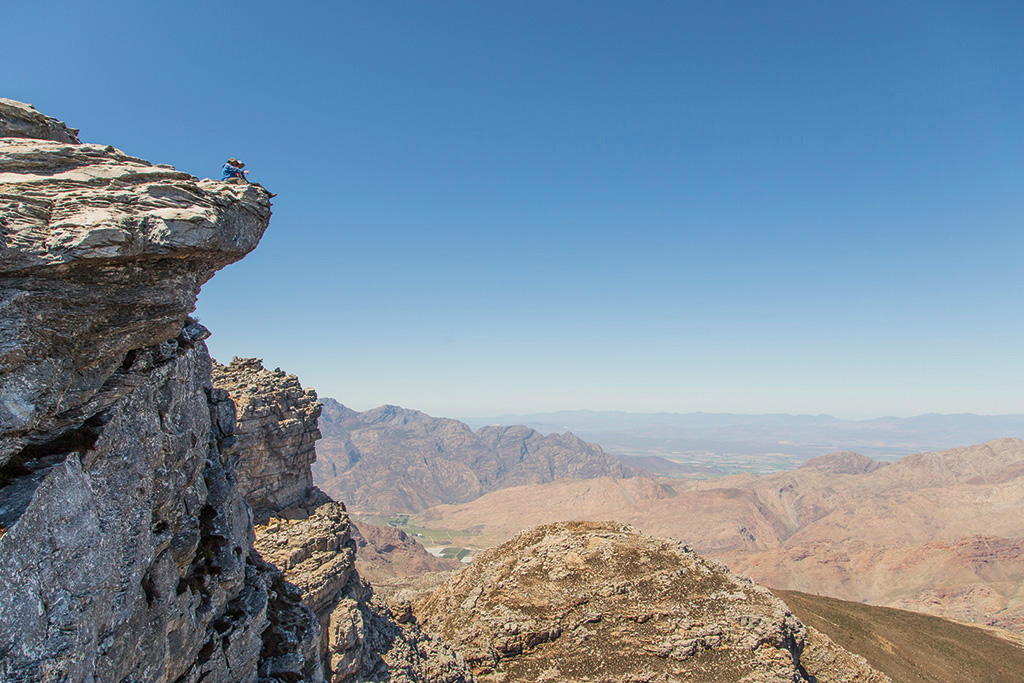
The Whole Nine Yards
Stage 1 Cederberg
Duration 7 days
Highlights Rock formations, pools and incredible vistas
Stage 2 Koue bokkeveld
Duration 6 days
Highlights Seldom-seen valleys and remarkable peaks
Stage 3 Skurweberge
Duration 7 days
Highlights Crossing the Atlantic/Indian Ocean watershed line
Stage 4 Hex River
Duration 7 days
Highlights Camping in the Amphitheatre
Stage 5 Langeberg
Duration: 7 days
Highlights Proteas, fynbos, great heights
Stage 6 Marloth
Duration 8 days
Highlights Exceptional flora, Klein Karoo views
Stage 7 Grootvadersbosch
Duration 7 days
Highlights Indigenous forests
Stage 8 Gouritz
Duration 8 days
Highlights Crystal streams, river crossing
Stage 9 Outeniqua
Duration 7 days
Highlights Rolling hills, old passes

A Gentler Matric Rage
Wild Nights Out is a youth project funded by the Rim of Africa Trust with the donations from its annual traverse. Through facilitated wilderness trails, matrics mark the end of their schooling and dream into their futures. The project includes teens from a wide variety of backgrounds, who can connect beyond their normal social circles. All applications are full scholarships. Date: 10–15 December 2019. Applications close 30 November. wildnightsout.co.za
Words and photography by Matthew Sterne
Also read:










